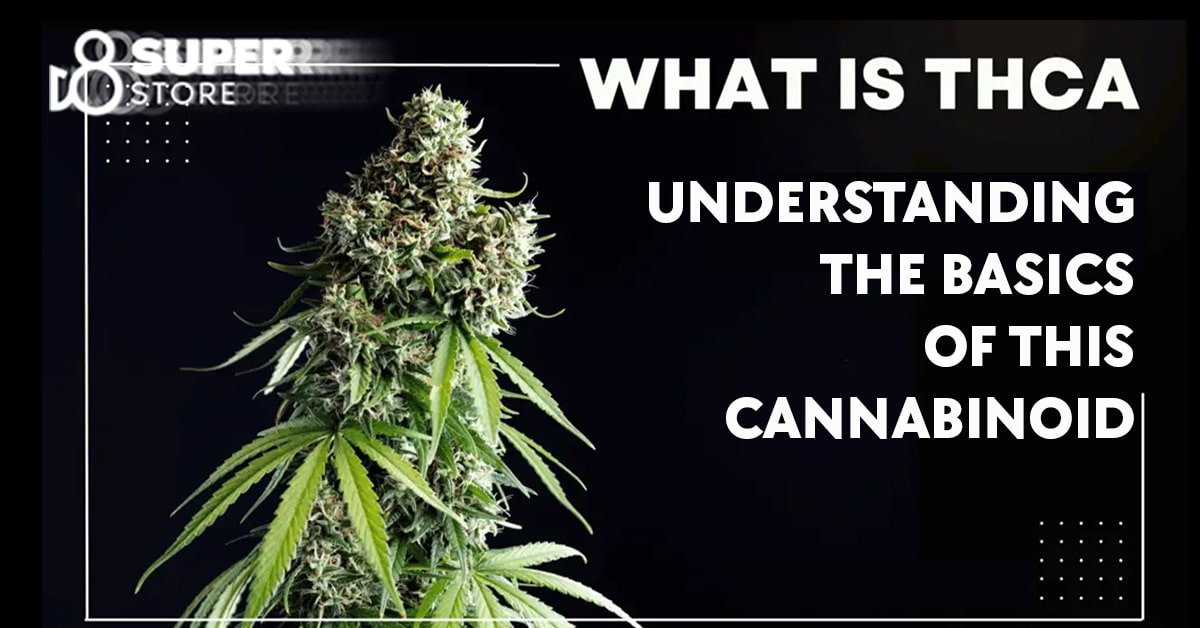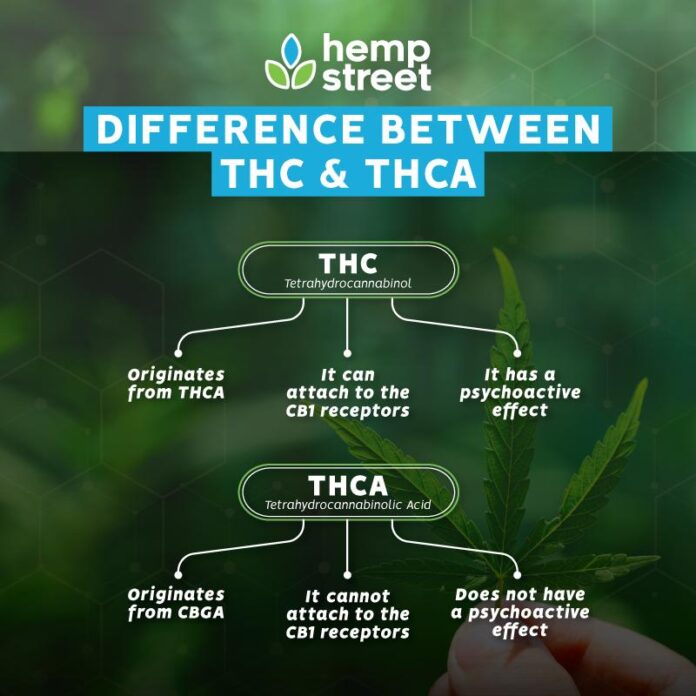Imagine a key that only reveals its shape when warmed in your hand – a subtle, chemical transformation that unlocks new possibilities.THCA, or tetrahydrocannabinolic acid, is that key in the cannabis plant: the raw, non-intoxicating precursor to the better-known THC. It lives in fresh and unheated cannabis, and under the right conditions – notably heat – it converts into the compound most people associate with marijuana’s psychoactive effects.
This article, “THCA Unlocked: Using it and Its Effects Explained,” will guide you through what THCA is, how it differs from THC, and why it has attracted attention from consumers, researchers, and regulators. We’ll look at the science behind decarboxylation (the process that “unlocks” THC), the ways people encounter THCA in products or raw plant preparations, and the current state of evidence about its effects and safety.
The landscape around THCA is evolving: labs are still probing its biological activity,markets are experimenting with new formats,and laws treat it differently from THC in some places.With a clear,balanced look at the chemistry,practical uses,legal considerations,and emerging research,this piece aims to give readers the context they need to understand THCA without hype – and to decide what,if any,role it might play in their own lives.
THCA Basics: What It Is,How It Differs From THC,and Why It Matters
THCA is the raw,non‑psychoactive precursor to the familiar molecule THC. In fresh cannabis it exists as tetrahydrocannabinolic acid – a large portion of cannabinoids in a newly harvested plant are in this acidic form. The extra carboxyl group keeps it from activating the brain’s CB1 receptors in the way decarboxylated THC does, so eating raw flower or drinking juiced cannabis won’t produce a high. Heat, light, or time trigger decarboxylation, releasing carbon dioxide and converting THCA into active THC.
The practical differences between the two compounds shape how people use cannabis and how laws and labs classify products. Below are some speedy contrasts to keep in mind:
- Psychoactivity: THCA – non‑intoxicating; THC – intoxicating.
- Form in the plant: THCA dominates fresh material; THC appears after heating/aging.
- Stability: THCA is heat‑sensitive and converts easily; THC is the thermally stable end result.
- Uses: THCA is explored for raw or topical applications; THC is used for inhalation, edibles, and traditional dosing.
| Property | THCA | THC |
|---|---|---|
| Psychoactive | No | Yes |
| Found in | Raw plant | Decarbed product |
| common uses | Juices,tinctures,topicals | Smoking,vaping,edibles |
Why this matters: consumers and clinicians are increasingly interested in THCA for its potential biological effects - from anti‑inflammatory and anti‑nausea properties to early neuroprotective signals in preclinical studies – while recognizing research is still preliminary. Practical choices affect outcomes: consuming raw THCA avoids intoxication but limits absorption pathways; applying heat can unlock THC’s psychoactive and systemic effects. For anyone experimenting,pay attention to product labels,storage,and preparation methods so you get the intended compound and dose.

How THCA works in the Body: Metabolism,Receptor Interactions,and Activation Pathways
Think of this molecule as the quiet sibling of THC: formed naturally in the living plant,it carries an extra carboxyl group that keeps it chemically distinct and largely non-intoxicating. When exposed to heat or prolonged drying, that carboxyl group is shed as carbon dioxide in a process called decarboxylation, unlocking delta‑9‑tetrahydrocannabinol (THC). in its native state, the molecule wanders the body more like a signaling guest than a full‑blown keynote speaker - present, active in subtle ways, but unlikely to trigger the classic “high.”
At the receptor level, THCA plays a quieter tune. Research to date suggests it has low direct affinity for the brain’s main cannabinoid receptors,CB1 and CB2,which helps explain its limited psychoactivity. Instead, it appears to influence a wider ensemble of targets that may modulate inflammation, pain and cellular signaling:
- TRP channels (e.g., TRPV1/TRPA1) – implicated in sensory perception and inflammation.
- PPARs - nuclear receptors involved in metabolic and anti‑inflammatory pathways.
- Enzymes like COX – potential interactions that could affect prostaglandin production.
The route of exposure dramatically shapes what you actually feel and how the body processes the molecule. Heat (smoking,vaping,baking) is the most efficient activator,reliably converting THCA to THC before or during absorption. Eating raw plant material or juicing keeps THCA largely intact, with effects that are slower, weaker and more peripheral. Once inside the body, any THCA that is converted or absorbed is subject to typical xenobiotic handling in the liver – phase I/II metabolism and likely glucuronidation - while microbiome and storage conditions can subtly influence conversion rates.
| route | Activation | Onset | Psychoactivity |
|---|---|---|---|
| Raw (juicing) | Minimal conversion | Minutes-hours | None to mild |
| Oral (edibles) | Partial heat conversion during cooking | 30-120 min | Variable (depends on decarboxylation) |
| Inhalation (vape/smoke) | Rapid, efficient conversion | Seconds-minutes | High (if converted to THC) |

Methods of Use and Dosage Guidance: Raw Consumption, Vaping, Topicals, and Safe Starting Protocols
Eating THCA raw - in juiced leaves, fresh flower blended into smoothies, or chewed as a micro-snack – preserves the acidic molecule and generally avoids intoxication. Raw consumption is the gentlest route: think small, vegetal portions rather than smoked doses.A single tiny leaf or a spoonful of finely chopped fresh flower is a sensible place to begin; as fresh weight and THCA concentration vary, observe how your body responds before increasing the amount.
Vaping and inhalation turn THCA into THC through heat, so these methods require extra caution if you want to control psychoactive effects. Use a low-temperature setting on a quality device, take very short puffs, and wait between inhalations to judge impact.Helpful practical cues:
- Low temp: set your device to the lower end of the manufacturer’s range.
- Short puffs: one to two-second inhales, exhale fully.
- Wait time: pause 15-30 minutes before another inhalation to assess effect.
- Clean devices: residues can alter dose and flavor-keep your hardware tidy.
Topicals and tinctures offer different experiences: balms and salves deliver localized relief without crossing the blood-brain barrier in most cases, while sublingual tinctures can produce milder systemic effects than inhalation. Below is a conservative starting guide to help you test a new format safely:
| Format | Starting Amount (approx.) | Wait/Assess |
|---|---|---|
| Raw (fresh) | Pea-sized or 0.25-1 g fresh | 30-60 minutes |
| Tincture (sublingual) | 1-3 drops (low-strength) or 2-5 mg THCA | 20-45 minutes |
| Vape | 1 short puff, then reassess | 15-30 minutes |
| Topical | Pea-sized request to area | 10-60 minutes (localized) |
Across all methods, follow a simple, safe protocol: start low, go slow, and keep notes. Track what you used, how much, the setting or temperature, and the time until effect. Avoid mixing with alcohol or sedatives while you’re learning your response, and if you have health conditions or take medications, consult a healthcare professional before experimenting. Small, mindful steps will reveal how THCA behaves for you without surprising effects.
Therapeutic Potential and Evidence: Pain Relief, Inflammation Control, Nausea Management, and What Research Shows
Therapeutic promise is real but tentative. laboratory and animal studies increasingly point to THCA as a non‑intoxicating cousin of THC with biological activity that could be useful for symptom relief. Researchers have observed anti‑inflammatory and neuroprotective signals in cell cultures and rodent models, and some patients report fewer aches and less nausea with THCA‑rich preparations. Having mentioned that, high‑quality human trials remain sparse, so all conclusions are provisional rather than prescriptive.
Pain and inflammation studies suggest multiple pathways. Preclinical work shows THCA can modulate immune and neuronal signaling in ways that reduce inflammatory markers and pain behaviors. Proposed mechanisms include interactions with nuclear receptors and ion channels that regulate inflammatory cascades and sensory neurons. Key pathways under inquiry include:
- PPARγ activation – may influence gene expression tied to inflammation and metabolism.
- TRP channels modulation – could alter nociception and sensory signaling.
- Enzyme inhibition (COX/mitochondrial pathways) – potential reduction in pro‑inflammatory mediators in lab models.
Nausea management is plausible but understudied. Because THC is a well‑known antiemetic via CB1 receptor activation,there’s interest in THCA as a non‑intoxicating alternative. Early reports and small observational series suggest some anti‑nausea effects, possibly through serotonergic or gut‑based signaling, yet controlled clinical data are largely absent. For people seeking symptom relief, anecdotal experience is encouraging but should be weighed against the lack of standardized dosing and rigorous safety data.
Practical takeaways-and the research road ahead. THCA’s therapeutic potential is promising across pain, inflammation, and nausea, but the evidence hierarchy currently sits at preclinical and anecdotal levels for most indications. Critically important considerations include uncertain dosing, product variability, and the fact that heating converts THCA to psychoactive THC. More randomized controlled trials, standardized formulations, and safety studies are needed before THCA can be recommended broadly; until then, clinicians and consumers should proceed cautiously.
| Symptom | Evidence Level | Notes |
|---|---|---|
| Pain | Preliminary | Analgesic signals in animals; human data limited |
| Inflammation | Promising | Reduces markers in vitro and in vivo |
| nausea | Limited | Anecdotal benefit; controlled trials needed |
| Neuroprotection | Early | Cell/animal models suggest protective effects |
Side Effects, Risks, and Legal Considerations: Harm Reduction Strategies and Compliance Tips
THCA can feel gentle for many users, but it’s not without predictable effects: dry mouth, mild dizziness, and changes in focus are commonly reported, while anxiety or an elevated heart rate can occur in sensitive individuals or with high doses. Interactions with prescription medications-especially blood thinners, sedatives, or drugs metabolized by the liver-can amplify risks, so a cautious approach is essential.If you have cardiovascular issues, a history of psychosis, or are pregnant or breastfeeding, err on the side of avoidance and consult a healthcare professional before use.
Reduce harm by treating THCA like any active substance: dose slowly, observe how your body reacts, and avoid multitasking that requires attention. Practical tips to keep in mind:
- Start low, go slow: begin with a fraction of a typical dose and wait several hours before redosing.
- Avoid mixing: don’t combine THCA with alcohol, benzodiazepines, or other depressants.
- No driving or heavy machinery: performance and reaction time can be impaired even if effects seem mild.
- Keep records: note dose, form, and effects to learn what works safely for you.
Regulatory landscapes vary wildly-what’s legal in one state or country may be restricted in another-so documentation and verification matter. Buy from reputable vendors offering third‑party lab results, retain purchase receipts, and check local statutes before traveling with any cannabinoid product. The short table below highlights simple compliance checkpoints:
| Check | Why | Action |
|---|---|---|
| Lab testing | Confirms potency & purity | Request COA, reject untested products |
| Local law | Determines legality | Verify government resources before travel |
| Labeling | Accurate dosing info | Prefer clear mg/mL and ingredient lists |
mitigate long‑term risks by storing products securely, using child‑resistant containers, and disposing of expired items responsibly.If you experience persistent adverse reactions, stop use and report the event to a healthcare provider or relevant regulatory body-early reporting helps protect others and can flag contaminated or mislabeled products in the market. Thoughtful, informed use keeps benefits accessible while minimizing harm.
Choosing Quality Products and Integrating THCA Into Your Routine: Sourcing, Label Reading, and Practical Usage Recommendations
When selecting THCA products, think like a detective: follow the paper trail from seed to bottle. Prioritize brands that publish a current certificate of Analysis (COA) from an ISO-accredited lab, disclose hemp strain origin, and describe their extraction method. Obvious companies will clearly list batch numbers, harvest dates, and whether COAs test for pesticides, heavy metals, and residual solvents.A clean supply chain and readable documentation are the fastest signals of quality.
Reading labels becomes effortless once you know what matters. Look for these essentials:
- THCA vs. THC: clear percentages for each; note whether values are reported on a dry weight or finished product basis.
- Total cannabinoids: not just THCA-know the complete cannabinoid and terpene profile.
- COA link or QR: an accessible lab report that matches the batch number on the bottle.
- Extraction and carrier: solvent-free methods and clean carrier oils for tinctures.
- Usage notes: whether the product is intended to be consumed raw, heated, or applied topically.
| Product Type | How It’s Used | Best For |
|---|---|---|
| Raw Flower | Juiced or lightly chewed (non-decarboxylated) | Those exploring non-psychoactive THCA |
| Tinctures | Sublingual drops; some are designed for heating | Controlled dosing and discreet use |
| Vape Cartridges | Vaporized-careful, heating converts THCA to THC | Fast onset, experienced users |
| Topicals | Applied to skin; local effect | Targeted, non-systemic use |
Integrating THCA into your routine is largely about simple, consistent habits: start low and go slow, keep a short usage log to track dose, timing, and any effects, and choose the delivery method that matches your goals. Store products in a cool, dark place in an airtight container to preserve potency and terpenes. Be mindful that heating converts THCA to THC-if avoiding psychoactivity is your aim, opt for raw forms or formulations explicitly labeled as non-decarboxylated. Lastly, check local regulations and consult a healthcare professional when combining THCA with other medications to ensure safe, informed use.
Key Takeaways
Like any key that fits a complex lock, THCA opens a door to questions more than it delivers definitive answers. We’ve walked through what THCA is, how people use it, and the effects and unknowns that accompany it – and what stands out is less a single story than a shifting landscape of science, law, and personal experience.
If you’re curious about trying THCA, think of it as an invitation to learn rather than a fixed destination: read the latest research, check legal restrictions where you live, and discuss potential interactions or health concerns with a medical professional. Responsible use means informed choices and realistic expectations.
As studies continue and public attitudes evolve, THCA will likely stay an intriguing piece of the broader cannabis puzzle. Keep paying attention, ask smart questions, and let knowledge guide your decisions – that’s the clearest way to unlock its place in your life.


